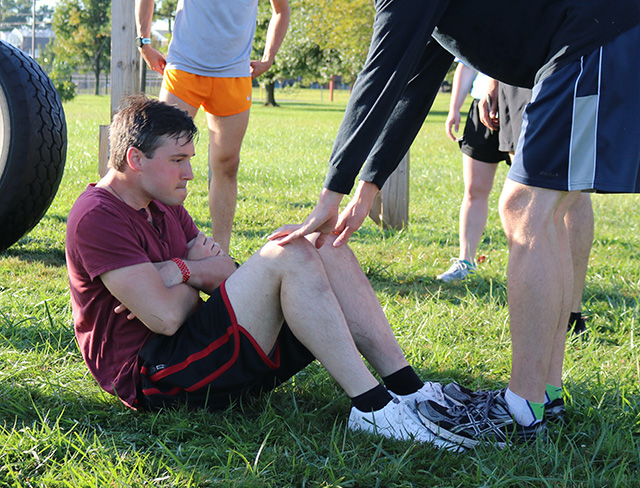The President's Challenge fitness award program has been largely replaced by those used for the FitnessGram Program. As such, the following curl up test has been replaced by the FitnessGram Curl-Up.
 sit up test
sit up test
There are two variations of the curl-up test which were used in testing for the President's Challenge - the 'curl-up test' and the improved 'partial curl-up'. The procedure for the standard and original curl up test is described below, in which the subject performs the maximum number of curl-ups in one minute. The procedure was improved for the President's Challenge partial curl-up test.
See the general guidelines for Abdominal Endurance Tests. There is also a similar simple sit-up test that you can do at home, or the 2-minute sit-up test performed in the US Army and US Marines and US Navy.
test purpose: The curl-up test measures abdominal strength and endurance, important in back support and core stability.
equipment required: you need a flat, clean, cushioned surface, stopwatch, recording sheets, pen.
pre-test: Explain the test procedures to the subject. Perform screening of health risks and obtain informed consent. Prepare forms and record basic information such as age, height, body weight, gender, test conditions. See more details of pre-test procedures.
procedure: The subject lies with knees flexed and feet approximately 12 inches from their buttocks. A partner assists by anchoring the feet to the ground. The arms are held flat across the chest, with the hands placed on opposite shoulders. The subject raises the trunk, keeping the arms in position, curling up to touch their elbows to thighs and then lowers back to the floor so that the shoulder blades (upper back) touch the floor. The maximum number of sit-ups performed in one minute is recorded.
scoring: The completion of one complete curl up counts as one. Make sure that the subject does not "bounce" off the floor - only correctly performed curl ups should be counted. The timer begins the test by calling out the signal "Ready? Go!". The stop watch is started at the same time, and at the conclusion of one minute the timer calls out "Stop" at which counting and the subject stop.
advantages: this test is simple and quick to perform requiring minimal equipment, and large groups may be tested at once.
disadvantages: a curl up with the feet held increases the involvement of the hip flexor muscles, making the test less valid as a measure of abdominal strength. The partial curl up test, in which the feet are not supported, is therefore a better measure of abdominal strength and endurance.
comments: The partner may assist by counting aloud the number of repetitions. It is important that the correct technique is used as described for accurate comparison to the norms. If using a variation of the test, the actual technique and procedure should be recorded with the results, and appropriate norm tables consulted.
guidelines: before conducting any fitness test, you should review each person's medical status to identify medical, orthopedic or other health problems that should be considered. Before starting, make sure the correct techniques for all tests are explained. (see the Fitness Testing Guidelines for more info)
The Test in Action
- This test was part of the President's Challenge fitness award program
Similar Tests
- President's Challenge partial curl up test.
- The similar Partial Curl Up Test used in the Connecticut Physical Fitness Test.
- Simple sit-up test that you can do at home
- Sit-up tests procedures for the US Army and US Marines and US Navy
Related Pages
- Puchase the sit-up test audio file
- General Abdominal Endurance Test description.
- About Abdominal Testing
- Online sit-up metronome where you can set your own pace.
- Videos of Sit Up Fitness Tests
- President's Challenge Fitness Awards
- Sit up exercise at the beach or at home
- All fitness tests list
- Sit-Up World Records


 Current Events
Current Events